|
Posted: 1/2/2019 3:51:34 PM EDT
[Last Edit: bagofcrabs65]
The purpose of this thread is to show you a way to pack a small aid bag or first aid kit. Before I get into the details of what I use in a kit that I carry in my vehicles and to the range, I want to go over a few things first.
1. Get training. I would recommend spending a few dollars and getting CPR trained and certified. You can do this through various organizations. The Red Cross comes to the forefront of my mind due to their presence all over America and the amount of classes they host. You can attend some TC3 or other high speed tactical medical classes if you like. I am not knowledgeable on what is available or what they will cost. However, a lot of local hospitals are starting to train/teach Stop The Bleed to their local communities free of charge. It is a 1 hour course that will train you how to use a tourniquet, how to apply pressure to stop a bleed, and it gives you a very quick and dirty example of possible triage you may have to do on a mass casually scene. For more information on these courses and to see if one is near you, visit https://www.bleedingcontrol.org/. 2. Practice what you have been taught. These are perishable skills. A tourniquet drill only takes a minute to do. Doing that once or twice in a month will go a long way in keeping you proficient enough to help someone. 3. Call 911. In America, we have a great EMS system. Transporting anyone that is hurt to a hospital and doctor is going to help them out much more than anything else we can do on the ground. Yes, we should try and stop the life threats. However, recognizing our limitations as first responders or a guy in the wrong place at the wrong time is crucial. The faster a patient can get to the doctor, the better their outcome will be. Do not assume someone else called 911. 4. The materials needed to properly treat someone are not cheap. Do not let that stop you from collecting this stuff over time though. In all likelihood, you will NEVER use a tourniquet or occlusive dressing on someone. So this is a buy once, cry once type of deal. You can buy decent materials from a reputable dealer and it will last you years. Remember, it is a good thing if you go home every day and your First Aid Kit/Bag did nothing but sit in your truck or car. 5. Take care of your equipment. A lot of this stuff is low maintenance. However, you should inspect it periodically to ensure it isn’t falling apart on you due to age or any other random act of god. Keep your kit in a dry place, out of the sun. If you live in a place where your car gets to extreme temperatures, perhaps you should check your equipment more often during those months. Putting together a First Aid Kit is extremely simple. People tend to get held up on how to pack their bag or how much of an item should they carry. There are a few ways to look at packing a bag. A. What is the purpose of this bag? Is it for life threats? Is it meant to treat everything that you could possibly encounter? Is it meant for a range trip? Is it meant for a car wreck? Is it meant to treat your family on a weekend camping trip? The purpose of the bag is important. It is ok to have multiple bags for different purposes if you want to do that. If you want a bag that does everything, then you are going to be looking at spending more money. If you just need a kit to keep someone alive long enough until EMS show up, then it will not be as expensive. There are also different things you will pack depending on the use. For example, a bag used for your weekend camping trip should focus on simple falls, scrapes, cuts, headaches, allergies and perhaps some splinting material. A kit for the range should focus on Hemorrhage. You will carry tourniquets, occlusive dressings, pressure bandages, perhaps Combat gauze. Both of these bags will likely have a tourniquet, some gauze and a pressure bandage. However, both bags will not carry Tylenol, sun screen or Benadryl. B. Is there anything special about you or your family? If you are building a kit for the camping trip, are there any medications you need? Do you need an EPI pen for your kid because they are allergic to bees? Are you on blood thinners or taking long term steroids? Things like this are important to keep in mind when packing your kit. C. You should pack your kit the way you go through your assessment on a patient. There are many ways to do assessments depending on a given situation. The most common one people think of without even knowing it is ABC’s. You learn the ABC assessment in CPR and quite frankly, if you know no other assessment, this one will get you through most of the stuff you will in the field. ABC stands for Airway, Breathing, and Circulation. Does the patient have a patent Airway? No? Do a head tilt chin lift or jaw thrust. Is the patient breathing? No? Why? Is it because they overdosed on an unknown substance or are they choking on something? Is their airway open? Circulation=pulse. Do they have a pulse? No? Start CPR. It is impossible to kill a dead person. So even if you are mistaken and they do have a pulse, they will likely let you know after a couple compressions to get off their chest. I use a modified version of the ABC assessment that some of you are familiar with. H: Hemorrhage A: Airway B: Breathing C: Circulation D: Disability or Decision to transport E: Everything else and exposure Hemorrhage. Stopping a massive hemorrhage is very important. That is why I put it before everything else. When I open up my first aid kit, the very first thing I have access to is a tourniquet. I little deeper into my bag I have access to gauze and ace bandages for pressure dressings. Airway, Breathing, and Circulation. This is done with my hands. No special equipment needed(with exception to a chest seal). I will reposition the patient to open their airway. I will give rescue breaths if they are not breathing. I will check their pulses and perform CPR if needed. I am not going to carry special airway equipment or anything that I would need to shove down someone’s through to get an airway. It is very invasive and quite frankly, most people are not trained on how to maintain or perform a procedure like a surgical cricothyrotomy or Rapid Series Intubation. I know some people are going to recommend you use a Nasopharyngeal Airway (NPA). I do not think there is a reason to carry one. They are uncomfortable for conscious patients. I they are unconscious and can’t breathe in a recovery position or from the head tilt chin lift, an NPA isn’t going to fix your problem. Some people may have been trained how to perform a Needle Chest Decompression (NCD). This is a highly invasive procedure. Stabbing a needle into a chest of a patient can lead to bad outcomes not only health wise, but legally down the road as well. Unless you are in the .mil working on soldiers or working under a license for a medical treatment facility or EMS, I would not entertain the idea. Disability and decision to Transport. If you are just a regular guy with some training, I want you to ignore the disability and think Decision to Transport. Did you call 911 yet? Everything else and Exposure. This is where you can treat minor wounds. This is where you can splint a broken leg or arm, cover your patient up to keep them warm and treat other non-life threatening injuries. I pack my medical kits with this assessment in mind. My tourniquets are the first thing I have access to. Right after my tourniquets, I have access to pressure dressing and gauze to put into wounds. My occlusive dressing and anything for advanced airway is next. At the very back or bottom or not even in my bag is the stuff for splinting, fixing headaches, or preventing an infection as just a few examples. The following kit is in both my vehicles. I can use it at the range as well. The purpose of the following bag is to help my family or friends incase of a car accident, range mishap or some other unforeseen accident resulting in life threating injuries that are treatable. I have personally trained my wife on how to use all of the equipment since she is the one person I spend most of my time with outside of my other best friend, work. I do not recall where I got this bag. It is an Orca Tactical bag. It is small and this is a picture of it with everything inside. I packed both my bags exactly the same, so they are easy to use and there is no confusion when it comes to finding something in the bag. Honestly, anything works when it comes to a bag. You just need something that is easy to access and protects your equipment. You do not need to spend a ton of money on a bag that is going to sit in your vehicle IMHO. With that being said, if you are a Military Medic reading this or you are going to walk 9,000 miles with this bag on, then you need to find something that works for you. There is a huge difference between a "truck bag" and a "walking bag". For my fellow military medics who are new...seek the advice of your fellow infantrymen when it comes to moving weight over long distances and do your research on good bags. For everyone else, a freaking plastic garbage bag could work if all it is going to do is sit in your car, keep the medical materials dry and safe. I do not recall what my bag cost or where I got it. However, it works just fine for what I need it to do. Bag with all of my equipment in it: 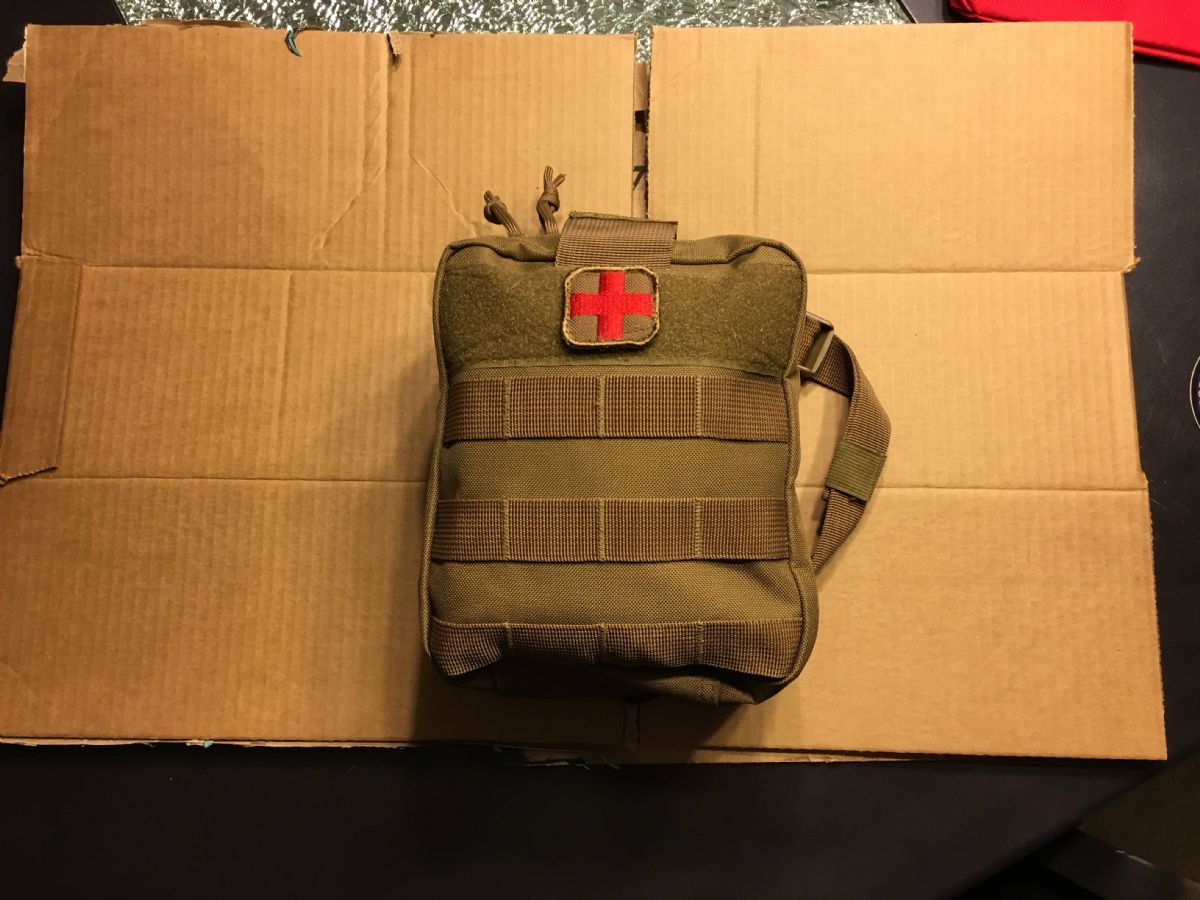
Side View: 
The back of the bag has MOLLE that is detachable if needed: 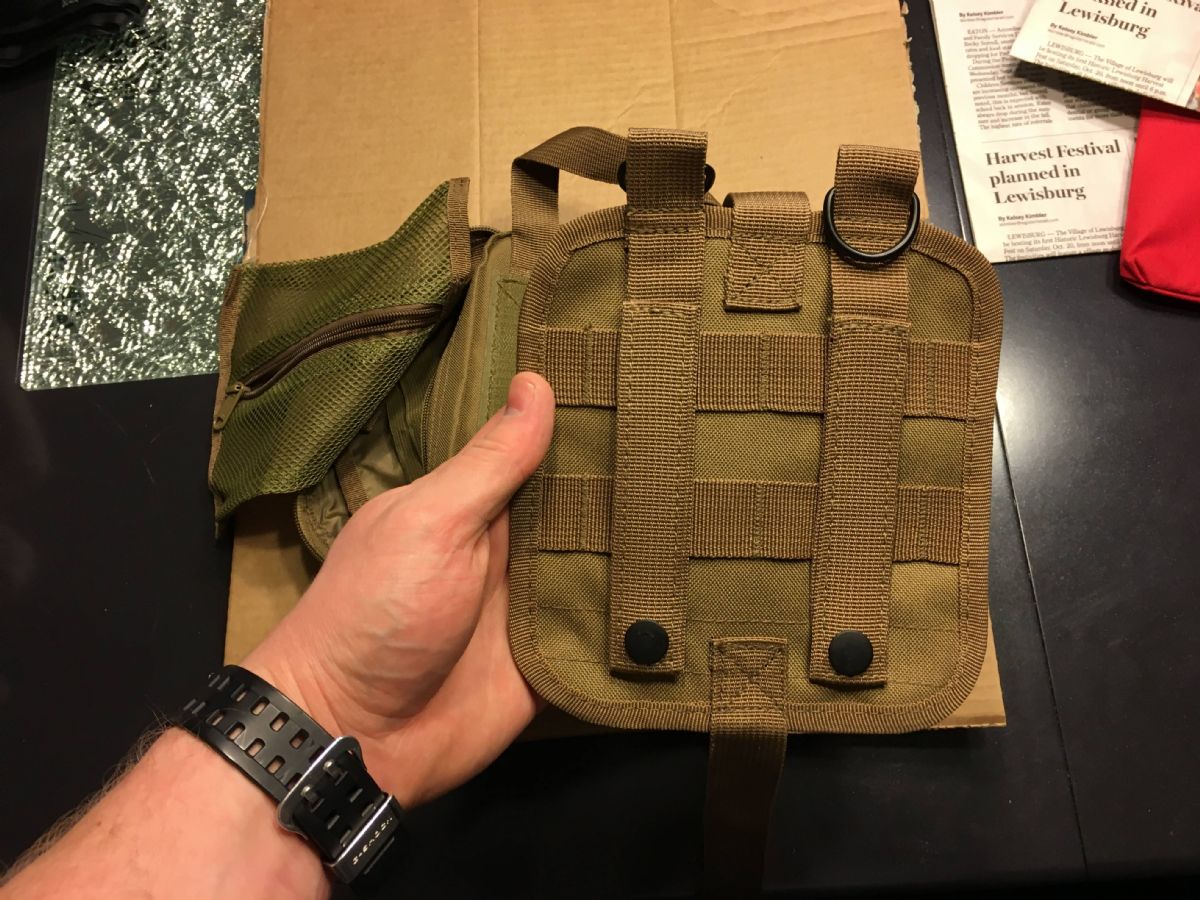

Here is what the bag looks like with nothing in it: 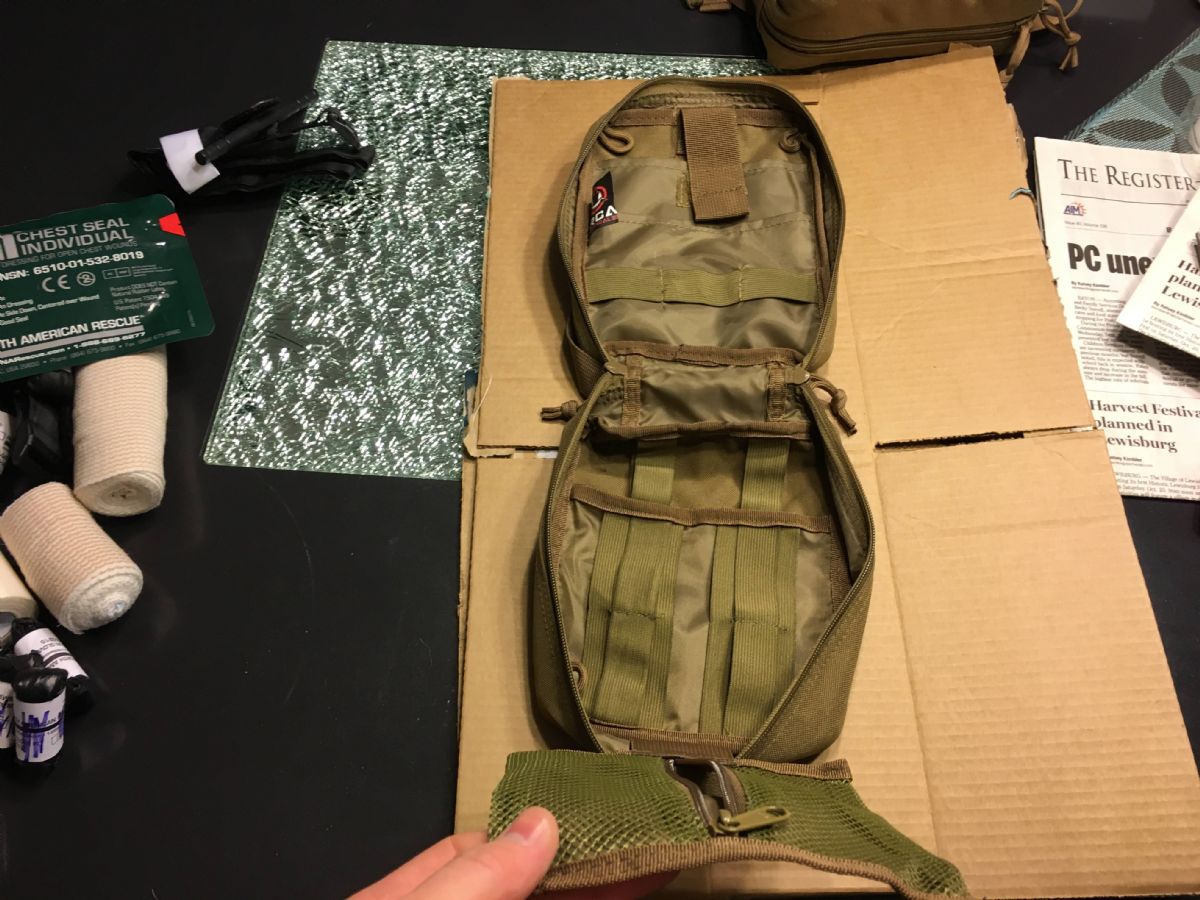
Here is what is in my bag. Gen7 CAT: 
I prefer the CAT over other tourniquet due to the ease of use, simplicity of training others in its use and overall quality. If this was a kit that only I carried to treat people, then I would also carry a SOF-T. However, this bag is meant to be used by myself and my wife. My wife is extremely intelligent. One of the smartest people I know and I work with doctors for a living. However, her experience in trauma, highly emotional/stressful situations, and overall training is minimal. She knows what I have taught her. I do not want to throw two different tourniquets at her in a life/death moment. It is easier for everyone involved if there is only one option and no one has to think about anything. Just take the CAT and put it on. I also have the CAT out of the plastic and the self adhering band is not through the friction adapter. I can easily pull the TQ out and wrap it around any limb I need to. These are the first Gen7 CATs I have owned. I am very impressed with them. They have simplified the tourniquet since I last used them. The biggest change I see in the Gen7 CAT vs older versions is the friction adapter. It looks thicker and the self-adhering band only has to be put through once. The older versions of the tourniquet, would require you to put the self adhering band through both portions of the friction adapter(when applying to another individual or leg wound) which could be tedious and took a lot of time to train and practice to not fuck up. The Hook/Pile tape would always get caught as you tried to feed the self-adhering band through. To understand what I am talking about, here is a picture: 
I have a set of trauma shears next to the tourniquet. These are not very expensive and the only item I picked up from Amazon. I have cut through multiple layers of clothing to include jeans, sweaters, leather jackets, and wool with no issues. 
Behind the tourniquet and scissors, I have 2 NAR compressed gauze and 1 occlusive dressing. I went with the Hyfin due to the size and easy of use. 
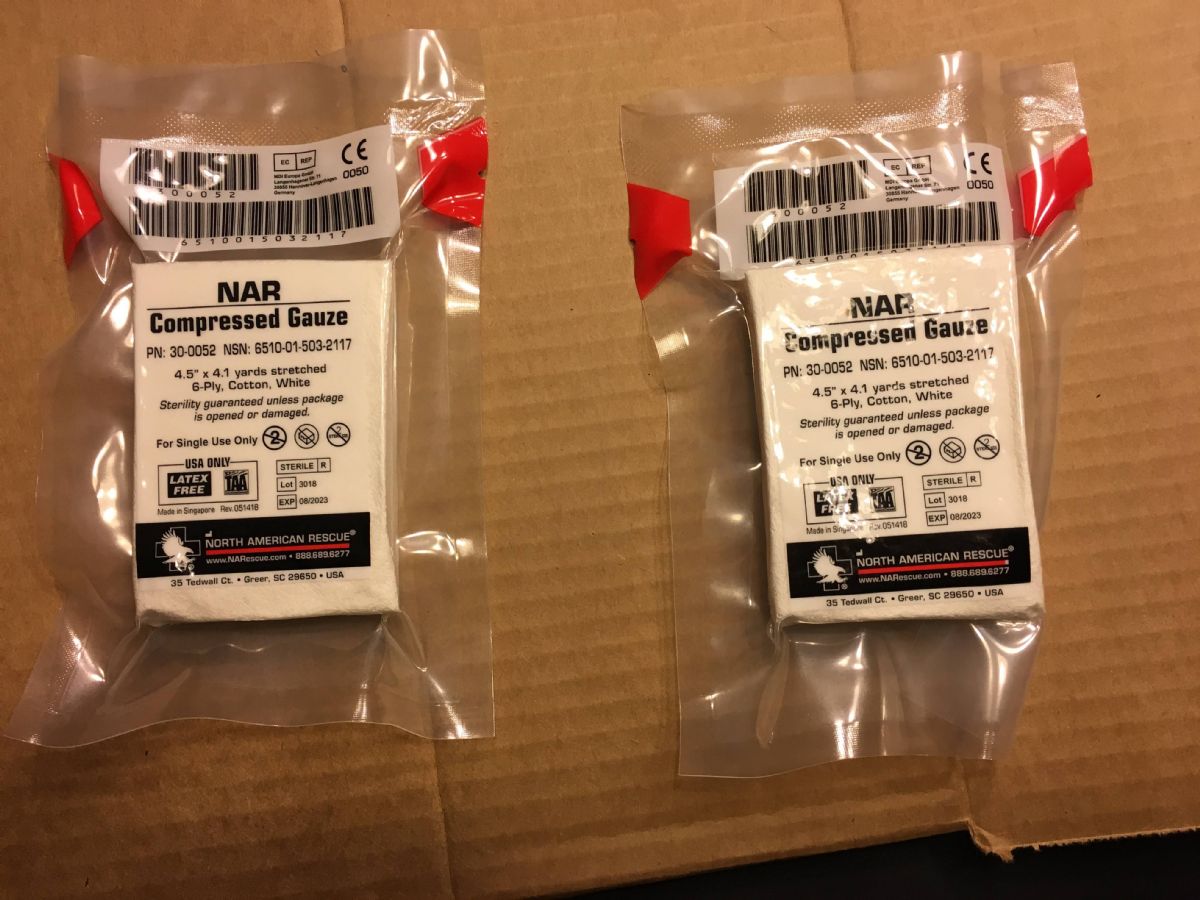
In the second portion of the bag, I have a 2 inch ace Bandage with hook/pile tape, 2 6inch ace bandages, and 2 Triangle bandages in a slot behind the ace wraps(I use wrap/bandage interchangeably here). Some will prefer an Israeli bandage over the ace bandages. This bag is meant for my wife and me. So I went with just ace bandages to keep the bag simple. Ace bandages are effective and have multiple uses. I can wrap fractures, wounds, ankles, whatever with bandage. They are great tools to have when treating a patient. I would recommend getting a 6 inch wrap over anything else if you to choose. It is easier to cover bigger wounds with a 6 inch wrap. The 2 inch was put into my kit because it fit and is useful for minor things like an ankle or hole in the hand. 

With the tape, I prefer silk tape. You can tape your tourniquets down. Tape your occlusive dressing down. You can write on your tape. You can do a lot of stuff with tape. Make sure to prep your tape by giving yourself a lip to grab. Just fold a small portion of the tape back onto itself. 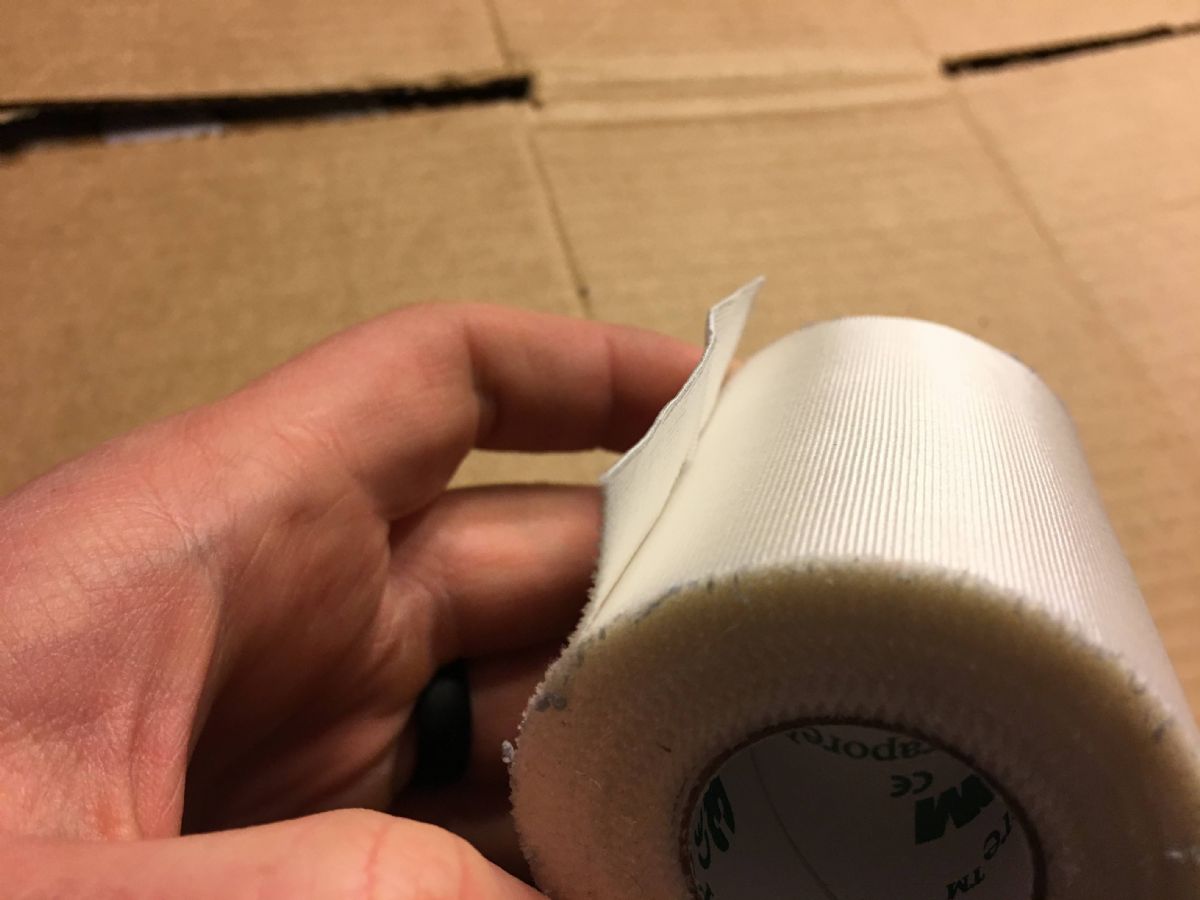
The triangle bandages are more for me than my wife. I love triangle bandages. I believe they are one of most underrated medical tools out there. You can splint with them, stuff them into a wound, creature pressure on a wound, create an improvised tourniquet on an arm...with just one triangle bandage. You may or may not add these to your kits. This is more of a personal preference than anything else. There are plenty of alternatives or you can just omit them completely. 
Lastly, I have 6 pairs of gloves that I purchased from North American Rescue. 3 pairs of extra large and 3 pairs of small(for my wife). I colored the small gloves with purple so I can easily distinguish the difference when I go to grab a pair. 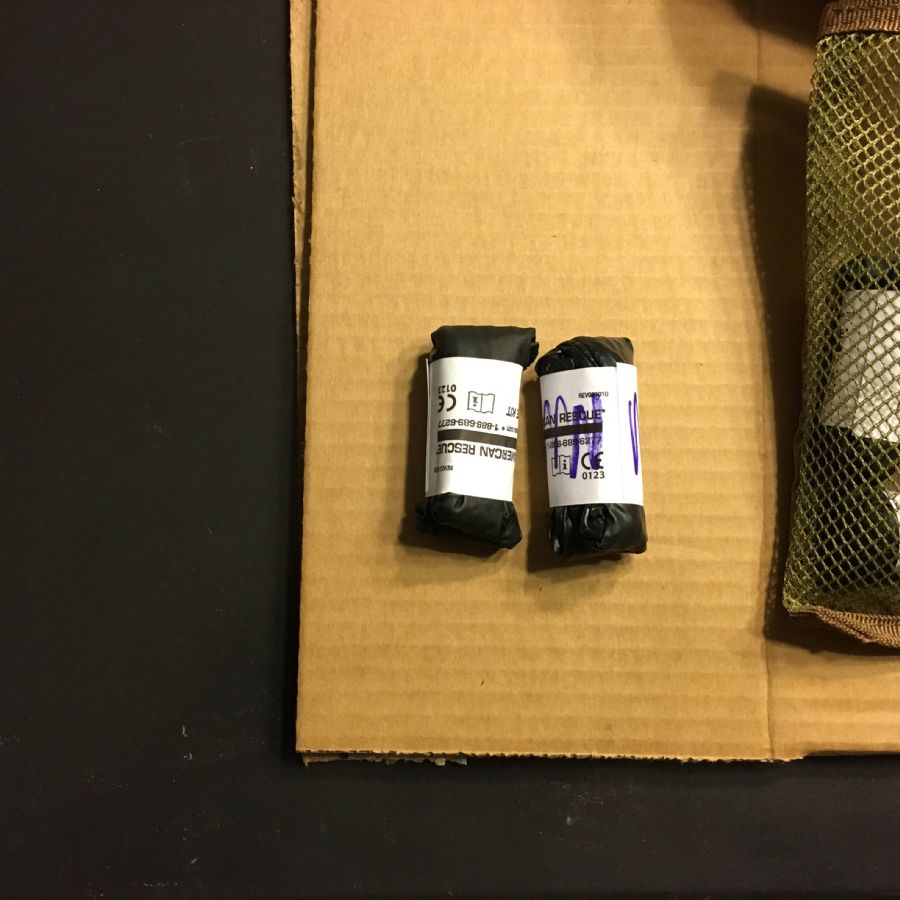
Here is a picture of what the bag looks like with everything in it and it is first opened. You will see the tourniquet in the center and easily accessible. The gloves are covering up the ace wraps and tape. Next to my TQ is the trauma shears. Behind the TQ is the 2 gauze and occlusive dressing. 
Once the gloves are moved away, I have access to my bandages and tape. 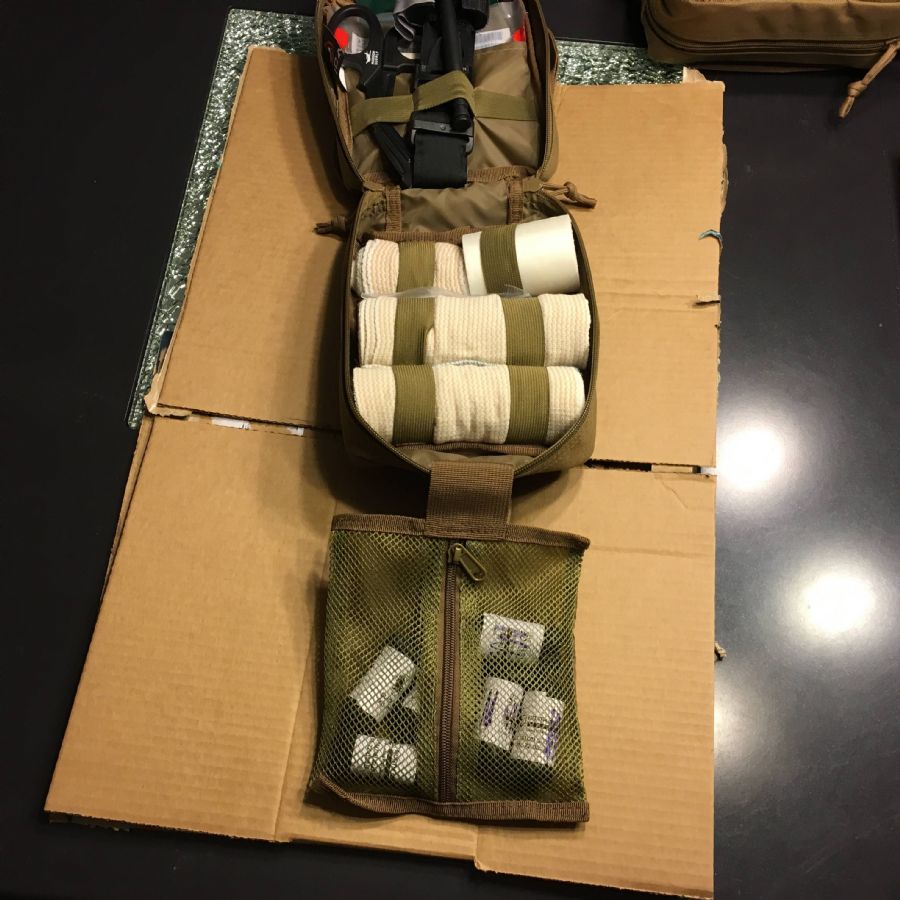
Perhaps some additions I may add in the future is a second CAT and a marker. The marker is useful for tracing the dead body and getting a good laugh when EMS comes to pick up the remains. (I'm joking). I may also look into Combat Gauze. With exception to the Trauma shears and Bag, I bought everything from North American Rescue. Here is the pricing as of 1/2/19: CAT: $29.99 Hyfin: $9.99 Ace wrap 6in: $1.99 Ace wrap 2in: $.99 Gloves: $15.99 for a pack of 25 Gauze: $2.99 Triangle Bandage: $6.99 From Amazon: Trauma Shears: $12.99 3in tape: $14.43 (Box of 4) I found the bag I have on the Orca Tactical Website. https://www.orcatacticalgear.com/ I do not know if I got it from them directly or through a deal somewhere else. First Aid Bag: $19.99 So, one of my bags with everything in it before shipping/tax: 1x CAT $29.99 1x Hyfin: $9.99 2x 6in Ace wrap: $3.98 1x 2in Ace wrap: .99 3in Tape: 14.43 6x Gloves: $39.98 (I had to buy two different sizes) 2x Gauze: $5.98 2x Triangle Bandage: $13.98 1x Trauma Shears: 12.99 1x Bag: $19.99 Total: $158.28 I put together 2 bags, but some items came in multiple when purchased. The second bag before shipping/tax is $97.89. (I didn't include the cost of gloves/tape since one order gives me more than I need) So, for roughly $260.00, you can put together a two decent first aid kits. That is a lot of money. However, I am sure with some price hunting, you can get better deals. I went to North American Rescue because I trust them and I know I won't get a fake product. There are plenty of reputable sites to get these items from. Here are some examples: Any ar15.com sponsor https://www.narescue.com/ https://www.chinookmed.com/ https://www.tacmedsolutions.com/ I also believe there is a sticky at the top of the forum with options as well. These are just a couple off the top of my head. I stated this earlier and I am going to say it again. I try to avoid Amazon when it comes to these products. When I need something to work, I want to know I have the real deal and that is why I am willing to pay a little more for that guarantee. A couple thoughts before I close this out. I did not put combat gauze into these kits for a couple reasons. 1. Cost. It is so damn expensive. 2. Keeping things easy. I know when to use Combat Gauze. My wife does not. I just want the kit to be simple and easy to use. Less choices equal quicker decisions. 3. By all means, use combat gauze. There is nothing wrong with using it. I love the product and if I was making an aid bag for my own personal use, I would add the C-Gauze. Know what you are building your kit for. Different kits require different items and will be packed differently. Get training. Purchase 1 extra of anything you plan on using. You can train/practice with the extra item. Never use a touniquet that you have not trained with. You only want to use a new tourniquet on patients. If you have no choice, then you can try and use a tourniquet you trained with, but it might break on you. They are a one use item. When it comes to training, save your stuff. Just because the gauze it pink from the fake blood, doesn't mean it can't dry out over a day or two. You can re-roll it and use it again to train more. Call 911. KISS principle (Keep It Simple Soldier or Keep It Simple Stupid) Don't overcomplicate things. Fix the problem and move on. I am looking forward to your critiques, questions, and anything additional you may have to add to the conversation. I will edit and add to this post over time and as things change. OP Background: I spent 9.5 years in the Army as a medic. I had two deployments to Afghanistan through that time. I have been through several TC3 courses with both dummies and live animals. I have trained soldiers, civilians, and foreign nationals in Combat Lifesaver, first aid, and advanced trauma medicine. I am currently an instructor for Stop the Bleed at the hospital I work for I am in my last semester of nursing school. I currently work at a level 1 trauma center in their ER and will pick up a position as a nurse this coming summer 2019. -There are multiple ways to effectively treat patients. Please do not take anything I am saying as the only way to accomplish the mission. There are people who have spent their entire lives studying the subject of emergency and tactical medicine that are far more knowledgeable than me and have the experience to back it up. The goal of this post is just to give some of you a starting point and perhaps a reference to get your own training and first aid kit started. |
|
|
|
|
GREAT post, thanks for taking the time to get this written!
|
|
|
"Anyone wanna see second prize? Second prize is a set of steak knives."
|
|
|
|
Well written, thank you.
|
|
|
|
|
Great post!
|
|
|
|
|
Advanced, Very Super Professional Regular Guy
|
@bagofcrabs65
Great write up! I use a very similar system. Same bag and all. I recently found that the NAR SIRK Gen 2 kits are available on Ebay for $75 - $100 shipped depending on the seller. It's a stellar deal. You get: Two (2) x Cat Gen 7! Benchmade Rescue Hook (this thing cuts through leather boots) Hyfin Chest Seal TPT Decompression Needle NAR S Rolled Gauze Quikclot Combat Gauze Compression Bandage Nasopharyngeal Airway with lube 2 sets NAR Bearclaw gloves Casualty Card with marker Duct Tape Eye Shield Here's my setup. Everything except for the scissors, Israeli gauze, blanket, and red bandage came in the SIRK Gen 2. |
|
I used to be undefeated in the Official Arfcom Keeper League, and then I got owned by Bryan_AIM. Bryan freakin rocks!
|
|
Advanced, Very Super Professional Regular Guy
|
Almost forgot....
One thing missing from both of our kits that I recently ordered is sterile burn dressing. Burns are pretty common and are often overlooked in trauma kits. The H&H sterile burn dressing packs pretty small and are cheap. $5-$7 shipped each from Ebay. They also double as triangular bandages. I ordered 10 of them recently and am adding a couple to each trauma kit. Thanks again for the great writeup. |
|
I used to be undefeated in the Official Arfcom Keeper League, and then I got owned by Bryan_AIM. Bryan freakin rocks!
|
|
NAR SIRK Gen 2 kits are a great deal.
|
|
|
|
|
Lots of fantastic info in this thread.
Only thing I could add right now, and it isn’t a big deal by any stretch, is to avoid black gloves. It’s a bit harder to see blood on black gloves. If wounds are obvious, it is irrelevant. However, if you are probing for wounds, it is harder to detect blood on black. To an extent. Again, not a big deal, just offering a different perspective. |
|
|
|
|
Good post. If you watch many Youtube vids on this you’ll see people that have no idea what they’re doing but are more than happy to “instruct” people. “IFAKs” with Tylenol and bandaids abound
 . .Originally Posted By CatSnipah:
Lots of fantastic info in this thread. Only thing I could add right now, and it isn’t a big deal by any stretch, is to avoid black gloves. It’s a bit harder to see blood on black gloves. If wounds are obvious, it is irrelevant. However, if you are probing for wounds, it is harder to detect blood on black. To an extent. Again, not a big deal, just offering a different perspective. View Quote 
|
|
|
|
|
Some more current research has shown that hemostatic gauze is not more effective than plain gauze. The key to wound packing is packing the gauze as deep as possible (to the point of the actual severed artery) and then holding ALOT of direct pressure on it for several minutes. This is significant because the expiration dates on hemostatic gauze is significantly less than plain gauze. Not to mention cost.
|
|
|
|
|
Originally Posted By cap6888:
Some more current research has shown that hemostatic gauze is not more effective than plain gauze. The key to wound packing is packing the gauze as deep as possible (to the point of the actual severed artery) and then holding ALOT of direct pressure on it for several minutes. This is significant because the expiration dates on hemostatic gauze is significantly less than plain gauze. Not to mention cost. View Quote |
|
|
|
|
Originally Posted By Everythingisawesome:
I trained with a PA (former 18D) who suggested that the composition of the gauze is also a significant factor. Not all gauze is created equal. View Quote |
|
|
|
|
Originally Posted By trails-end:
Agreed. Thank you. View Quote View All Quotes View All Quotes Originally Posted By trails-end:
Originally Posted By mattvon:
GREAT post, thanks for taking the time to get this written! Thank you for this post. |
|
|
When all else fails, lower your expectations.
|
|
Thanks for this thread and the info. Fiancee is a teacher and we picked up a couple NAR stop the bleed kits for her to keep in her classroom desk. Taking one of the stop the bleed classes next month.
|
|
|
|
 Win a FREE Membership!
Win a FREE Membership!
Sign up for the ARFCOM weekly newsletter and be entered to win a free ARFCOM membership. One new winner* is announced every week!
You will receive an email every Friday morning featuring the latest chatter from the hottest topics, breaking news surrounding legislation, as well as exclusive deals only available to ARFCOM email subscribers.
AR15.COM is the world's largest firearm community and is a gathering place for firearm enthusiasts of all types.
From hunters and military members, to competition shooters and general firearm enthusiasts, we welcome anyone who values and respects the way of the firearm.
Subscribe to our monthly Newsletter to receive firearm news, product discounts from your favorite Industry Partners, and more.
Copyright © 1996-2024 AR15.COM LLC. All Rights Reserved.
Any use of this content without express written consent is prohibited.
AR15.Com reserves the right to overwrite or replace any affiliate, commercial, or monetizable links, posted by users, with our own.

